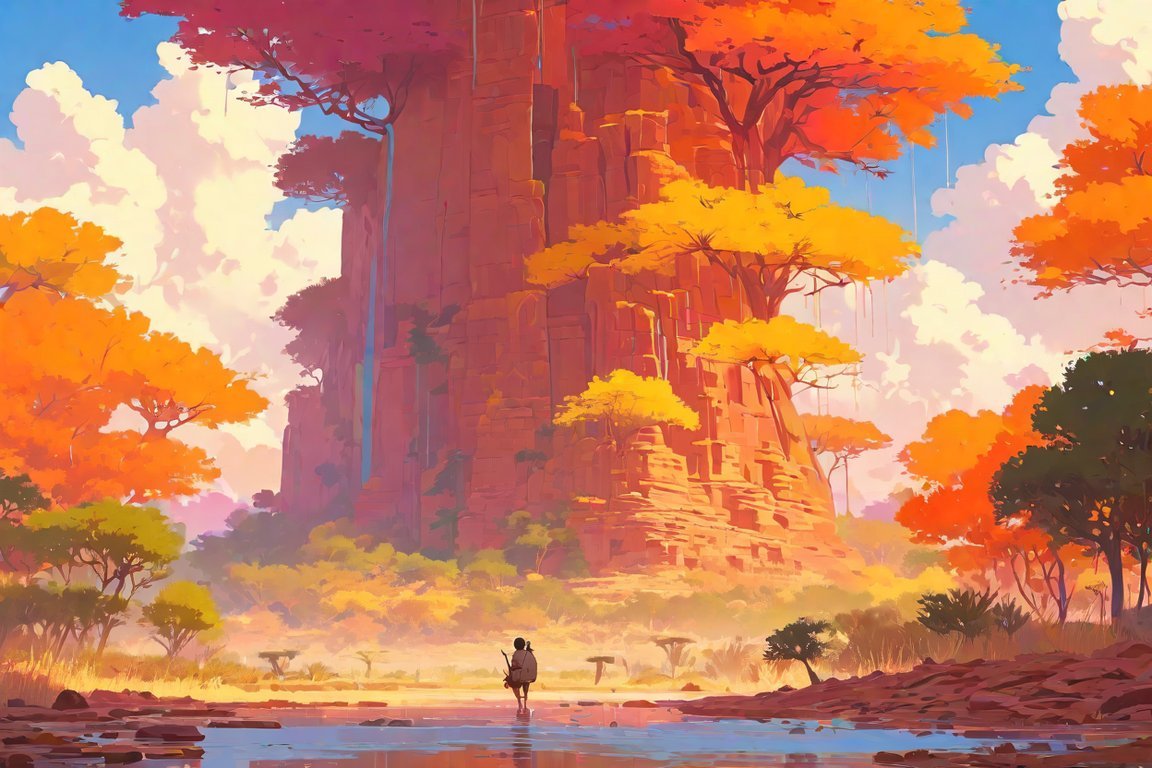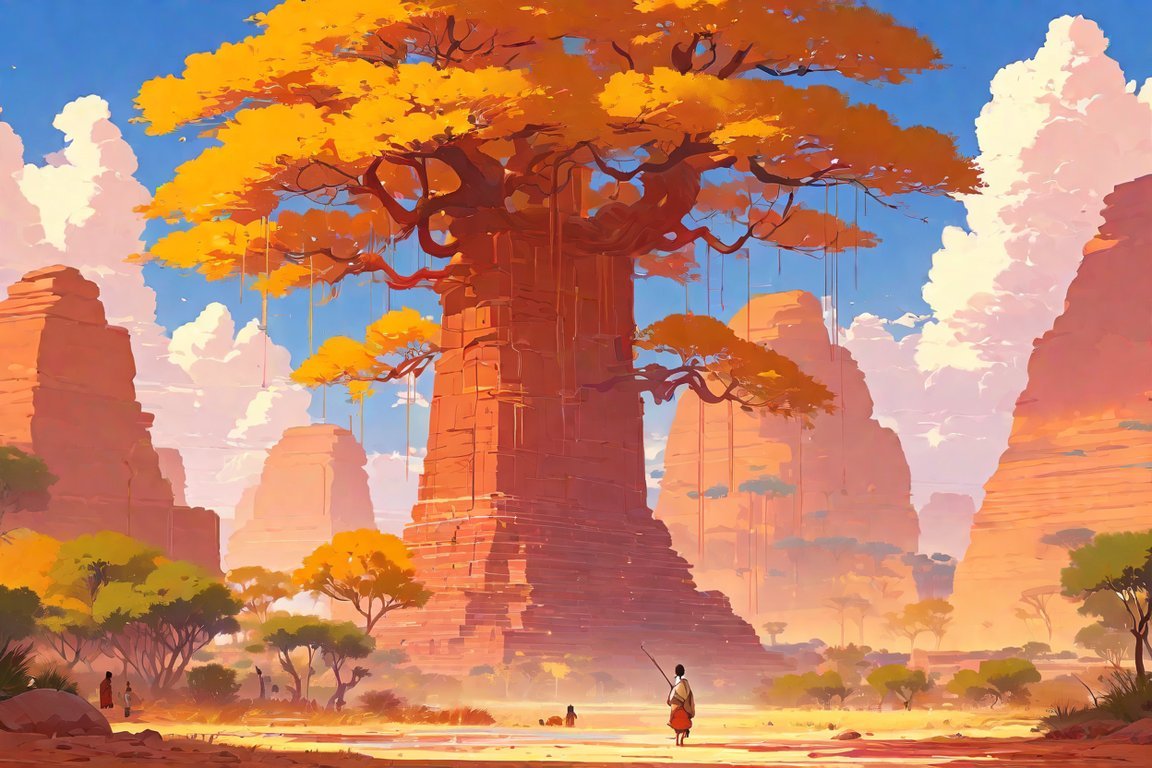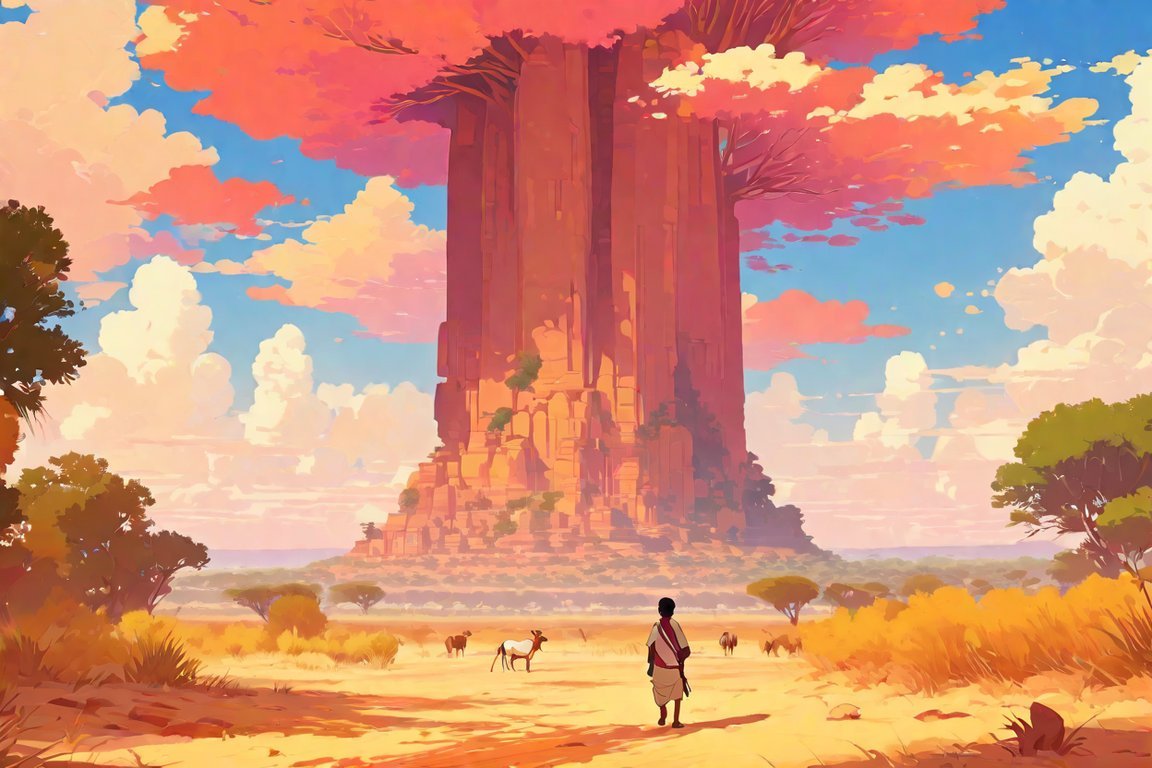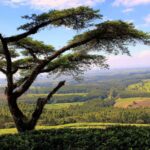Discover Fascinating Facts About Chad’s Cultural Traditions & Natural Beauty. Embark on a captivating journey through the lesser-known wonders of Chad, a country brimming with enchanting cultural traditions and breathtaking natural beauty. From the intriguing rituals of diverse communities to the awe-inspiring landscapes that stretch as far as the eye can see, Chad offers a wealth of hidden treasures waiting to be explored. Join us as we delve into the untold stories and untamed natural heritage of this fascinating nation, igniting your wanderlust and expanding your global perspective.

Key Takeaways:
- Chad is a landlocked country in northern Central Africa and is the world’s 21st largest country by land area.
- It has a diverse landscape, ranging from a desert zone in the north to an arid Sahelian belt in the center and a more fertile Sudanian Savanna zone in the south.
- Chad is home to over 120 languages and dialects, with Arabic and French as the official languages.
- The country has abundant reserves of gold and uranium.
- The national dish of Chad is boule, a thick porridge made from millet or sorghum.
- Camel racing is a traditional sport in Chad, particularly in the northern region.
- Chad has a high rate of early marriage and polygamy, with approximately 39% of girls marrying by the age of 15.
- The people of Chad are referred to as Chadian, and the currency used is the Central African Franc (XAF).
- The capital and largest city of Chad is N’Djamena.
- Lake Chad, one of the largest freshwater lakes in Africa, serves as an important water source.
- Chad has a diverse population consisting of over 200 ethnic groups.
- Chad is the largest among the 16 landlocked countries in Africa.
- Despite Chad’s passion for football, the country has never qualified for the final round of the FIFA World Cup.
- The national symbols of Chad are the goat and lion.
- Chad has endured three decades of civil war, which has greatly impacted the country’s stability and development.
Interesting Facts About Chad
Chad, located in northern Central Africa, is a country that is rich in cultural traditions and natural beauty. Let’s dive into some captivating and lesser-known facts about this enchanting nation.
1. A Land of Geographical Diversity
Chad is a landlocked country with a diverse landscape. In the north, you’ll find a vast desert zone, while the center is characterized by an arid Sahelian belt. Moving south, you’ll encounter a more fertile Sudanian Savanna zone, which showcases the country’s natural beauty.
2. Linguistic Melting Pot
With over 120 languages and dialects spoken, Chad is a truly diverse country. Arabic and French serve as the official languages, reflecting the confluence of cultures within its borders.
3. Abundant Natural Resources
Chad is known for its ample reserves of gold and uranium, which contribute to its economy. These valuable resources have played a significant role in the country’s development.
4. Sprawling Land Area
Covering a vast expanse of land, Chad is the world’s 21st largest country in terms of area. Its size allows for a wide range of landscapes and ecosystems, making it a fascinating destination for nature enthusiasts.
5. Unique Cuisine
When it comes to food, Chad has its own distinct flavors. The national dish, boule, is a thick porridge made from millet or sorghum. It is often enjoyed with various accompaniments, such as stews or sauces, adding to the country’s culinary diversity.
6. Camel Racing Tradition
In the northern region of Chad, camel racing holds a special place in the hearts of the Chadian people. This traditional sport not only showcases the country’s cultural heritage but also provides entertainment for locals and visitors alike.
7. Complex Marriage Practices
Chad has a high rate of early marriage and polygamy, with around 39% of girls being married by the age of 15. This aspect of the country’s social structure sheds light on the diverse cultural norms and practices prevailing in different communities.
8. Rich Ethnographic Tapestry
Chad is a melting pot of ethnic groups, with over 200 diverse communities spread across its territory. Each group has its own unique customs, traditions, and languages, contributing to the country’s cultural richness.
9. Currency and Capital
The official currency of Chad is the Central African Franc (XAF). N’Djamena, its capital and largest city, is a vibrant hub that offers a glimpse into the country’s contemporary lifestyle and urban development.
10. Expansive Lake Chad
Lake Chad, one of Africa’s largest freshwater lakes, is an essential water source for the people of Chad. Spanning across several countries, it serves as a lifeline for agriculture, fishing, and the surrounding ecosystems.
11. Struggles and Resilience
Chad has faced its share of challenges, including three decades of civil war. However, the resilience of its people shines through, exemplifying their determination and ability to overcome adversity.
12. Football and National Symbols
While Chad has not yet played in the final round of the FIFA World Cup, football holds a special place in the hearts of Chadians. The national symbols of Chad are the resilient goat and the powerful lion, representing both the country’s agricultural roots and its strength.
In conclusion, Chad is a country that offers a treasure trove of cultural traditions, striking landscapes, and extraordinary experiences. Exploring its fascinating facts opens up a world of wonder and enriches our global perspective. Embark on a journey to this remarkable nation and discover the hidden gems that await you.
Check out these fascinating facts on architecture that will blow your mind: facts on architecture
Discover intriguing information about the coastal plains that will leave you in awe: facts about the coastal plains
Did you know these interesting facts about macarons? Prepare to be amazed: facts about macarons
Unearth the secrets of the magnificent Karnak Temple with these mind-blowing facts: facts about Karnak Temple
Indulge in a delightful journey with these mouth-watering facts about churros: facts about churros
Satisfy your curiosity about boba with these fascinating facts that will leave you craving for more: facts about boba
Experience the slimy wonder of slime with these eye-opening facts: facts about slime
Dive into the enchanting world of coastal plains and uncover intriguing facts you never knew: facts about coastal plains
Embark on an adventure through time with these captivating facts about the Maya civilization: interesting facts about the Maya civilization
Explore the sweetest side of dessert with these delectable dessert facts: dessert facts
Remember to click on the links to immerse yourself in the world of knowledge and discovery!
The ancient rock art found in Chad’s Ennedi Massif
The Ennedi Massif, located in northeastern Chad, is a captivating natural and cultural wonder. Its ancient rock art and unique geological formation have attracted explorers, researchers, and nature enthusiasts from around the world. Let’s delve into the fascinating facts about the ancient rock art found in Chad’s Ennedi Massif.
Natural History
The Ennedi Massif is a remarkable sandstone formation shaped by thousands of years of water and wind erosion. Standing as a bulwark in the Sahara Desert, surrounded by vast sand dunes, it offers a breathtaking sight. The massif’s distinct geological features and striking landscapes make it a truly extraordinary place.
Archaeological Significance
One of the highlights of the Ennedi Massif is its collection of ancient rock art. These petroglyphs, or rock paintings, date back approximately 7,000 years. They depict various scenes, providing a glimpse into the hunting, dancing, and everyday lives of the people who once inhabited the area. The rock art found in the Ennedi Massif is a valuable archaeological and cultural treasure.
Habitat and Biodiversity
Beyond its geological and cultural significance, the Ennedi Massif also serves as a habitat for diverse flora and fauna. It is home to a rich collection of wildlife, including the rare Desert Crocodile. The presence of permanent water sources within the massif supports the survival of various plant and animal species, making it a biodiversity hotspot.
Environmental Threats and Conservation Efforts
Unfortunately, the Ennedi Massif faces environmental threats such as climate change and human activities. However, efforts are being made to protect and preserve this unique natural heritage. African Parks, an organization dedicated to wildlife protection and park management, is actively involved in conservation efforts in the area.
Exploration and Cultural Significance
The Ennedi Massif has long captivated the attention of explorers and researchers due to its geological wonders and rock art. Considered a cultural treasure, there have been endeavors to document and conserve the ancient rock paintings for future generations. Its exploration not only deepens our understanding of Chad’s history but also showcases the resilience and creativity of past civilizations.
Key Takeaways:
- The Ennedi Massif in Chad’s Ennedi Plateau is a remarkable sandstone formation shaped by water and wind erosion.
- It is known for its collection of ancient rock art dating back approximately 7,000 years, providing insights into the lives of past inhabitants.
- The Ennedi Massif is not only a geological wonder but also a habitat for diverse flora and fauna, including the rare Desert Crocodile.
- Conservation efforts led by African Parks aim to protect the Ennedi Massif from environmental threats and preserve its natural heritage.
- The exploration of the Ennedi Massif showcases its cultural significance and contributes to our understanding of Chad’s history.
Sources:
1. Ennedi Massif And Rock Art, Chad – WorldAtlas
2. Ennedi Massif: Africa’s remote geological wonder – BBC Travel
The importance of Lake Chad as a vital water resource
Lake Chad plays a crucial role as a vital water resource for millions of people in Chad, Cameroon, Nigeria, and Niger. Its significance extends beyond being a mere source of water, providing essential support for various aspects of life in the region.
Sustainability amidst diversity
Lake Chad’s hydrologic contributions and biological diversity make it an invaluable regional asset. It supports unique ecosystems and biodiversity, qualifying it as a wet zone of international importance recognized by Ramsar sites. The different ecological niches it encompasses contribute to a thriving habitat for a wide range of flora and fauna.
A bird haven
One of the remarkable features of Lake Chad is its status as an important ecological niche for migratory birds. With over 350 bird species listed there, the lake serves as a vital habitat for these avian travelers. It plays a crucial role in their migration patterns, making it a significant site for bird enthusiasts and nature lovers alike.
Historical and cultural significance
Beyond its environmental contributions, Lake Chad holds immense historical and cultural importance. The region has an association with historic African kingdoms and has witnessed important archaeological discoveries. Its presence has also been felt in the context of trans-Saharan trade, enriching the cultural fabric of Chad and neighboring countries.
A looming environmental crisis
Unfortunately, Lake Chad has been shrinking dramatically since the 1960s, posing severe environmental challenges. Climate change, population increase, and unplanned irrigation have been the primary drivers behind this alarming decline. The lake has reduced in size by a staggering 90%, resulting in the loss of crucial habitat for diverse animal species.
Implications for local communities
The shrinking of Lake Chad has severe implications for the local communities that depend on it for their livelihoods. The decrease in water availability threatens the region’s agricultural practices, economic activities, and overall well-being of the people. It highlights the urgent need for sustainable solutions to address this pressing environmental issue.
Preserving a precious resource
Efforts are being made to address the decline of Lake Chad and preserve this important water resource for future generations. Multiple stakeholders, including governments, NGOs, and international organizations, are striving to find sustainable ways to mitigate the crisis. The protection and restoration of Lake Chad are essential for preserving its role as a vital water source and maintaining the region’s ecological balance.
Key Takeaways:
- Lake Chad serves as a vital water resource for Chad, Cameroon, Nigeria, and Niger.
- It is an important wet zone of international significance, supporting unique ecosystems and biodiversity.
- The lake is a crucial habitat for over 350 bird species, contributing to their migration patterns.
- Lake Chad has historical and cultural significance, with links to African kingdoms and trans-Saharan trade.
- The shrinking of Lake Chad due to climate change and human activities poses environmental challenges.
- The decline of the lake has severe implications for local communities’ livelihoods.
- Sustainable efforts are underway to address the crisis and preserve Lake Chad for future generations.
Sources:
- Britannica. [^1^]
- Nature, UNESCO. [^2^]
- Ramsar sites. [^2^]
- BBC. [^3^]
- Kidadl. [^3^]
[^1^]: Britannica – Lake Chad
[^2^]: UNESCO – Lake Chad
[^3^]: BBC – Lake Chad: The World’s Most Complex Humanitarian Disaster
The incredible wildlife and national parks of Chad
Chad, a captivating country in northern Central Africa, is blessed with a diverse wildlife population and stunning national parks. From majestic elephants to powerful lions, Chad’s wildlife offers a glimpse into the beauty of nature. However, challenges like poaching and habitat loss threaten these magnificent creatures. Let’s delve into the fascinating world of Chad’s wildlife and discover the efforts being made to protect them.
Chad’s Rich Wildlife
Chad is home to a wealth of wildlife, showcasing the country’s exceptional biodiversity. From bush elephants and West African lions to buffalo and Kordofan giraffes, the wildlife in Chad is truly remarkable. Not to forget the antelopes, African leopards, cheetahs, hyenas, and various species of snakes that add to the vibrant ecosystem.
The Threat of Poaching and Habitat Loss
Sadly, the populations of large carnivores in Chad have significantly declined due to poaching and habitat loss. Poaching, particularly for the ivory industry, poses a serious threat to elephants. The lucrative trade in ivory puts these gentle giants in danger. Additionally, extensive deforestation has resulted in the loss of natural habitats for wildlife.
Conservation Efforts to Protect Wildlife
Despite the challenges, Chad recognizes the importance of preserving its wildlife. The country has established protected parks and reserves to safeguard its diverse species. One notable example is Zakouma National Park, which serves as a crucial habitat for large mammals such as scimitar horned oryx, addax, and dama gazelle. Efforts like these highlight Chad’s commitment to wildlife preservation.
Lake Chad: A Haven for Flora and Fauna
Lake Chad, an iconic freshwater lake bordering Nigeria, Niger, and Cameroon, is a haven for diverse flora and fauna. The lake is rich in aquatic plant and fish species, while crocodiles and hippopotamuses thrive in its waters. Moreover, Lake Chad plays host to a significant bird population, including migratory species, captivating birdwatching enthusiasts from around the globe.
Protecting Chad’s Wildlife Heritage
While the protected parks and reserves in Chad aim to conserve the country’s wildlife, the persistent threat of poaching remains a challenge. Efforts are being made to address this issue and protect the incredible wildlife that Chad possesses. By supporting initiatives focused on conservation, we can contribute to the preservation of Chad’s natural heritage for generations to come.
Key Takeaways:
- Chad’s wildlife includes bush elephants, West African lions, buffalo, giraffes, leopards, cheetahs, and various snake species.
- Poaching and habitat loss pose significant challenges to Chad’s wildlife.
- Protected parks and reserves aim to conserve the country’s wildlife, with Zakouma National Park serving as an important habitat.
- Lake Chad is rich in flora and fauna, with diverse aquatic plants, fish species, crocodiles, and hippopotamuses.
- Chad is home to a significant bird population, including migratory species.
- Conservation efforts need to address the threats of poaching and habitat loss to protect Chad’s wildlife.
Sources:
- Wildlife of Chad – Wikipedia
- USAID detailed study on “Considerations of Wildlife Resources and Land Use in Chad”

FAQ
Q1: What is the Ennedi Massif and its significance in Chad?
A1: The Ennedi Massif is a massive sandstone formation in Chad’s northeastern region. It holds archaeological significance with its collection of ancient rock art, dating back around 7,000 years. Its unique geological features and cultural treasures make it an intriguing destination for explorers and researchers.
Q2: How diverse is Chad’s wildlife population?
A2: Chad boasts a diverse wildlife population, including bush elephants, West African lions, buffalo, hippopotamuses, Kordofan giraffes, antelopes, African leopards, cheetahs, hyenas, and many species of snakes. However, the populations of these large carnivores have significantly declined due to poaching and habitat loss.
Q3: What are the environmental threats faced by Lake Chad?
A3: Lake Chad has been rapidly shrinking since the 1960s due to climate change, population increase, and unplanned irrigation. This shrinking has severe implications for the loss of habitat for various animal species and the livelihoods of local communities. Efforts are being made to address this crisis and preserve Lake Chad as an important water resource.
Q4: What are the cultural and historical significance of Lake Chad?
A4: Lake Chad holds historical and cultural significance, as it is known for its association with historic African kingdoms and its role in trans-Saharan trade. The region has also been the site of important archaeological discoveries. Additionally, Lake Chad serves as an important ecological niche for thousands of migratory birds, playing a crucial role in their migration patterns.
Q5: How is Chad addressing the challenges of wildlife conservation?
A5: Chad has established protected parks and reserves to conserve its wildlife, such as Zakouma National Park. However, poaching and habitat loss continue to be major threats. Conservation efforts in Chad need to focus on addressing these challenges to protect the country’s diverse wildlife.
- Unveiling Bernhard Caesar Einstein’s Scientific Achievements: A Legacy in Engineering - July 15, 2025
- Uncover who is Jerry McSorley: CEO, Family Man, Business Success Story - July 15, 2025
- Discover Bernhard Caesar Einstein’s Scientific Contributions: Unveiling a Legacy Beyond Einstein - July 15, 2025















